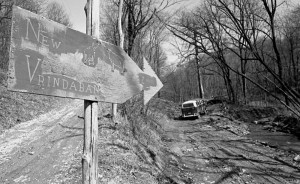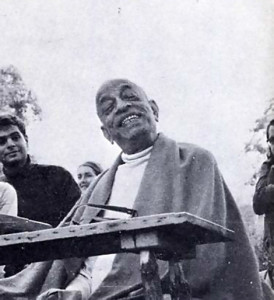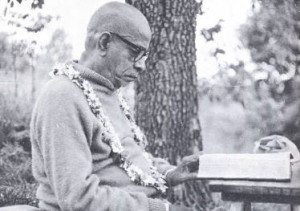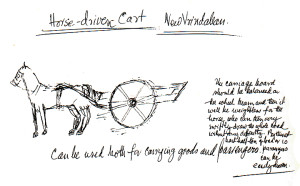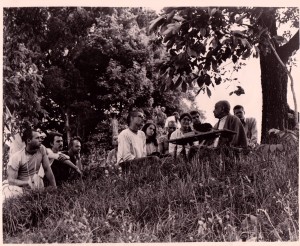Prabhupada’s First Visit to New Vrindaban – Spring 1969
A Swami’s Dream Comes to Life: Prabhupada’s First Visit to New Vrindaban
Written by Madhava Smullen. Archival Research by Chaitanya Mangala.
New Vrindaban, May 20th, 1969 – A small cluster of devotees waited at the entrance to the rural West Virginia property, hearts beating with anticipation. As the Lincoln town car turned the corner, they hit the gravel driveway in obeisance.
Srila Prabhupada stepped out of the car. “Oh, there are many waiting here,” he said, looking around with a smile that lit up his entire face. “Jai Sri Krishna!”
The devotees smiled back. They had been waiting for this moment since they first told Prabhupada in March of the previous year that they were negotiating with landowner Richard Rose.
From then on, Srila Prabhupada had been writing streams of enthusiastic letters to them, outlining his ambitious plans: that the land be called New Vrindaban; that “cow protection should be [its] main business;” that it be “a new place of pilgrimage for you Western devotees” and “an ideal village where the residents will practice plain living and high thinking.”
Even before Hayagriva told Prabhupada that the 99-year-lease had been signed on August 8th, 1968, he went as far as to say, “I may permanently stay there and try to serve you in constructing a New Vrindaban city in West Virginia,” expressing that it would be the ideal place for him to spend the rest of his life translating spiritual literature. And now he was here.
Excitedly, the devotees loaded Prabhupada’s luggage into the old powerwagon they planned to drive him up the dirt road to the farm in. As Srila Prabhupada took his seat, they started it up. The vehicle lurched, coughed out smoke, and promptly died. They tried it again. And again. Each time, it cut out. The devotees, mortified, looked at their guru. This wasn’t how they had hoped his first visit would go.
“Why not walk?” he said, matter-of-factly. It was a subtle way of pointing out, right from the get-go, that the simple life was superior to that of so-called modern “convenience.” And despite the devotees’ protests that it would be too hard on him, he set off at a smart pace up the ominously named “Aghasura Road,” a twisting, turning two-mile trail riddled with potholes and ruts.
As usual, Prabhupada’s much younger disciples were left huffing and puffing as they struggled to keep up with him. Head held high, he casually discussed the trees, flowers and vines along the way, interested in everything and finding ways to relate it all to Krishna consciousness. In just his first few minutes at New Vrindaban, he was already teaching his disciples his key instruction for the project, the glue that held it all together: loving Krishna.
At last, Prabhupada and the devotees rounded a curve in the road, and could see a clearing on the ridge ahead. There, amidst the lush green of the West Virginia countryside, was a small farmhouse, a barn, and the hand-built one room cabins that devotees resided in.
After washing and appreciating the devotee’s simple lodgings, Prabhupada sat down on a dais set up for him beneath a willow tree’s leafy cascade. Devotees brought him fruit, local tulip honey and fresh milk from New Vrindaban’s first cow, Kaliya. Then they sat before him in a semi-circle on the grass, looking up at him expectantly as he sipped it.
“I haven’t tasted milk like this in fifty years,” he said in wonder.
As Ranadhir Das paraded the milk’s maker, Kaliya, before him, he admired her, commenting that the Vedas calculate a man’s wealth in cows and grains.
Encouraged, the devotees told him that they hoped to get their own hive next year. “Then you will have the land of milk and honey complete,” Prabhupada said. “That is nature’s design, that everything is given complete for a happy life. We don’t require artificial amenities. All we need to realize Krishna is here.”
Prabhupada again made the same point when Lavanga-latika Dasi brought him a silver cup of water, freshly drawn from the well. “Oh, it is very sweet water,” he said. “That is Krishna. That is the way of remembering Krishna. It is so easy here at New Vrindaban.”
He then told the devotees how the morning sun at New Vrindaban could remind them of Krishna’s bodily effulgence; the cow of Krishna’s name Govinda, one who gives pleasure to the cows; and the countryside of His statement in the Gita that He is the sweet fragrance of the earth.
For Prabhupada, seeing New Vrindaban come to life was like seeing a dream come true. He had been planning a community like this since long before he had even travelled to the United States from India. While alone in Delhi back in 1956, he had written a series of articles in his Back to Godhead magazine, detailing his vision for a community where people would live a simple life based on the teachings of the Bhagavad-gita. And right from the beginning of ISKCON, he often told his disciples he wanted them to start a farm project. And they had done it! Prabhupada looked around at them with a broad grin that was almost childlike in its enthusiasm.
Sometime later, as he continued to chat with the devotees and look around the property, Paramananda Das finally succeeded in getting the powerwagon up the hill. Devananda and Prabhupada’s servant Purushottam carried Prabhupada’s luggage, including a big trunk packed with manuscripts, into his room. They then set the room up to his specifications, with a mattress on the floor and his Radha-Krishna Deities in a small cherrywood room attached to the bedroom.
Prabhupada liked his new room, with its two windows that opened out onto a view of the big willow tree. Quickly, he made himself at home, and settled right into his usual routine.
Always revolving around Krishna, Prabhupada’s day would begin in the wee hours as he rose to dictate his books. In his memoir, The Hare Krishna Explosion, Hayagriva Das recalls waking up at 2:00am and seeing the light on in his room.
At 4:00am, Prabhupada would attend mangal-arati, watching the Deities intently and striking his trademark steel gong as twenty devotees crammed into the small temple room on the first floor of the farmhouse. He would then perform arati to his own Radha Krishna Deities, and chant his rounds in his room while the devotees did the same downstairs.
After breakfast, Devananda would massage him with mustard seed oil outside in the morning sun. Throughout the day, he would dictate letters, take walks, and hold meetings at his favorite spot beneath a persimmon tree with the devotees gathered around him on the grass.
In the evening, he would lead kirtan in the temple room, encouraging the devotees to dance. Then he’d give a lecture, darshans in his room, and finally rest, before beginning it all again.
The days passed, lengthening gradually, bees buzzing lazily against blue skies and brilliant green trees, brief showers falling in the afternoons. Meanwhile, Srila Prabhupada built his fledgeling community, guiding the devotees as they sat with him beneath the persimmon tree.
Sometimes his instructions were practical. He told his disciples that he would show them how to build simple mud houses at practically no cost; that they should buy the adjoining property and build a bridge “so that gentlemen will come;” and that they should call their waterfall Keshi Ghat, their hills Govardhana, and their lakes Radha-Kunda and Shyama-Kunda.
He sketched his own design of a two-wheel cart for workhorses. He talked about protecting cows and bulls as father and mother, and how they could provide all transportation, fuel, and dairy needs. And he laid out plans for establishing the varnashram system and building temples, a guesthouse, and living quarters. He even discussed a gurukula for spiritual education, although there were only three boys in the community so far.
His ambition amazed the devotees, and his strength and vision kept them positive. “Someday you may see that it’s a great asset,” he told them when they complained about the pothole-ridden Aghasura Road. “Someday there may be many cottages by the road, and people will be driving up to see. Don’t be discouraged.”
At other times, Srila Prabhupada’s instructions were more philosophical. He stressed the importance of chanting and reading, citing the six Goswamis of Vrindavana as role models. And he pointed out how the hard work of simple country life was perfect for developing Krishna consciousness.
“They are hypnotized by Krishna,” he commented once, as he watched the young men work in the fields. “That is samadhi. Samadhi doesn’t mean inactivity. It means being completely absorbed in Krishna. Anyone chanting Hare Krishna is in samadhi. Anyone cooking for Krishna or writing for Krishna or working in the field for Krishna is in samadhi because the consciousness is: ‘I am doing this for the satisfaction of Krishna.”
Most of all, however, Prabhupada stressed how important it was for New Vrindaban residents to communicate and cooperate with each other, always with “Loving Krishna” as the connecting thread.
“You must jointly work,” he said during a conversation with Kirtanananda, Hayagriva, Shyama Dasi and other managers on June 9th. “There may be sometimes disagreement, but you should settle up. Otherwise how you can make progress?”
“Everyone will cooperate,” he added. “Why not? It is Krishna’s. Nobody is actually the in-charge. Krishna is in charge. We are simply assisting Krishna. In that spirit we shall work…. Everyone should think that ‘I am acting to satisfy Krishna.’”
By June 14th, now in his fourth week at New Vrindaban, Prabhupada was looking robust and seemed to be greatly enjoying the rest, fresh air, spring water, cow’s milk and of course the devotees’ association. They, too, were full of bliss in his.
But on June 18th, upon receiving a letter from Mukunda about the progress his disciples were making in London, Prabhupada decided he must fly to England immediately. The New Vrindaban devotees, who had been hoping he would spend the entire summer with them, were crestfallen.
On June 22nd, Prabhupada’s last night in New Vrindaban, all the devotees crowded into his room, eager to catch his last words. Amidst some light talk of his upcoming travels, he confided in them that personally, he would like to stay in New Vrindaban and finish translating Srimad-Bhagavatam.
As the evening wore on, six-year-old Dwarkadish began to nod off, as did his friend, five-year-old Ekendra. Prabhupada, who had developed a playful rapport with the two during his stay, smiled.
“So, you are feeling samadhi, Mr. D. D. D. ?” he asked. “All right. Let him take rest. And you are also feeling samadhi, Mr. Ekendra? You are very good boys. You can also take rest.“
At this, the devotees sensed that it was time to let Prabhupada himself take rest. But they remained in his room for some time more, hoping to soak up every precious moment they could. At last, they all offered obeisances and left his room.
The next morning, Srila Prabhupada left as he had come, striding down Aghasura Road at a brisk pace, his suitcases following him on a horse-drawn cart. As he got into his car and pulled away, the devotees saw him off with chants of “Hare Krishna!” and “Jaya Srila Prabhupada!”
Watching until long after his car had faded into the distance, they thought about how they could make this New Vrindaban community work, if only they followed Prabhupada’s instructions to love Krishna, live simply and work cooperatively together.
“I will also come again,” he had said just two nights before. “I like it so much here, but first I must finish the little work still remaining. I want to go once to London and Germany. Then I’ll entrust the whole preaching work to you. So do not become too anxious. With cooperation, everything will be possible. Krishna will help you.”
Remembering these words, the devotees turned back to continue their service of developing their transcendental farm community, and to begin their eager wait for Srila Prabhupada’s next visit.
